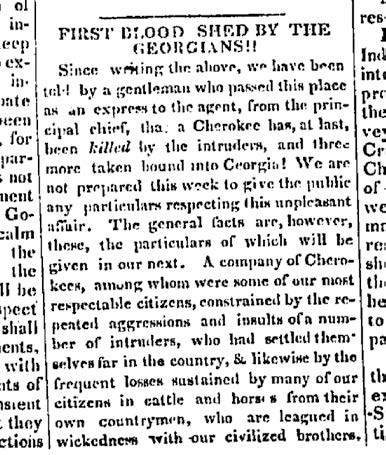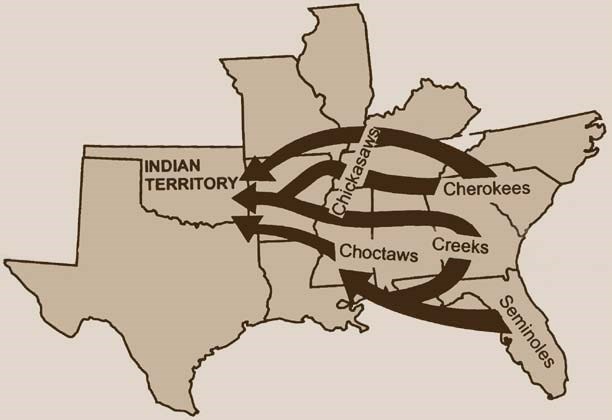Last updated: November 12, 2021
Article
Cave Springs and the Trail of Tears

Image courtesy of Dorothy Sullivan
The Trail Where They Cried
The Cherokee Nation once spread across Georgia, North Carolina, Tennessee, and Alabama. It was home to thousands of men, women, and children. The 1830 Indian Removal Act required that the Cherokee surrender their land and move west. Many actively opposed the act and refused to move.
In the spring of 1838, soldiers established forts and camps across the Cherokee homeland and swiftly rounded up every Cherokee they could find. The Cherokee knew this was coming, and chose to resist removal by waiting in their homes to be forcefully evicted by militias. In the camps, they suffered from exposure, disease epidemics, inadequate sanitation, and heartbreak, remaining prisoners in the camps until their final deportation to the West.
“The soldiers came and took us from home. They first surrounded our house and they took the mare while we were at work in the fields and they drove us out of doors and did not permit us to take anything with us, not even a second change of clothes…They marched us to Ross’ Landing, and still on foot, even our little children, and they sent us off.”
- Oo-loo-cha, widow of Sweet Water, 1842
“First Blood Shed by the Georgians”
Seventeen white families from Georgia and Alabama illegally took possession of Cherokee homes in the Beaver Dam settlement in February 1830. Cherokee Chief John Ross responded by sending a mounted police force, the Light Horse Brigade, to evict them. Major Ridge, David Vann, and the brigae went from home to home, forcibly evicting the white intruders and burning empty Cherokee structures to discourage future settelement. Retaliation came the following day in the death of one of the Cherokee and the imprisonment of others.
Beaver Dam marked the most prominent instance of active Cherokee resistance to unauthorized white settlement on Cherokee lands. The log strucutre at the site stood witness to the event; its one of the last remnants of Beaver Dam in today's Cave Spring and Vann's Valley. After this incident, the Cherokee sought only political solutions to intrusions from Georgia and no longer attempted to forcibly evict whites.

NPS Image

Images/Library of Congress

Image/Cherokee Phoenix and Indians’ Advocate, Wednesday, February 10, 1830
“…a Cherokee has…been killed by the intruders, and three more taken bound into Georgia!…A company of Cherokees…started the other day, under the authority of the Principal Chief to correct, at least part of the evil…They found…17 families of intruders, living, we believe, in Cherokee houses. These they ordered out and after safely taking out their bedding, chairs, &c. the houses were set on fire. In no instance was the least violence used on the part of the Cherokees.”
- Cherokee Phoenix and Indians’ Advocate, Wednesday, February 10, 1830

NPS Image
Federal Indian Removal Policy
Federal Indian removal policy aroused fierce and bitter debate. Supporters of the policy claimed it was a benevolent action to save the tribes east of
the Mississippi River from being overwhelmed and lost in the onslaught of an expanding American population. Opponents decried its inhumanity and the tragic consequences it had for the Indian peoples. One thing was certain; removal freed millions of acres of desired Indian lands for use by white settlers.
The Indian Removal Act of 1830 resulted in the removal of thousands of American Indians from their ancestral lands for new homes in Indian Territory
(present-day Oklahoma). They traveled by existing roads and rivers. Many groups, hoping to avoid the disease and heat of summer travel, left in the fall and instead faced treacherous winter weather. Many died during the ordeal of the Trail of Tears.
Today
Despite the hardships of the journey, members of the five removed tribes established new lives in the West. They stand as successful sovereign nations, proudly preserving cultural traditions, while adapting to the challenges of the 21st century.
Cherokee who survived the Trail of Tears created a new sovereign nation in present-day Oklahoma. Some Cherokee remained in North Carolina and due to a special exemption formed the Eastern Band of Cherokee Indians

NPS Image


